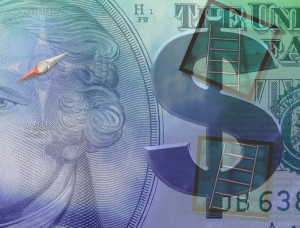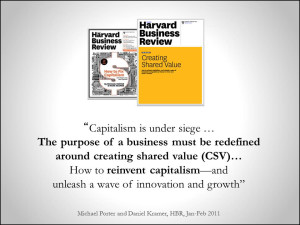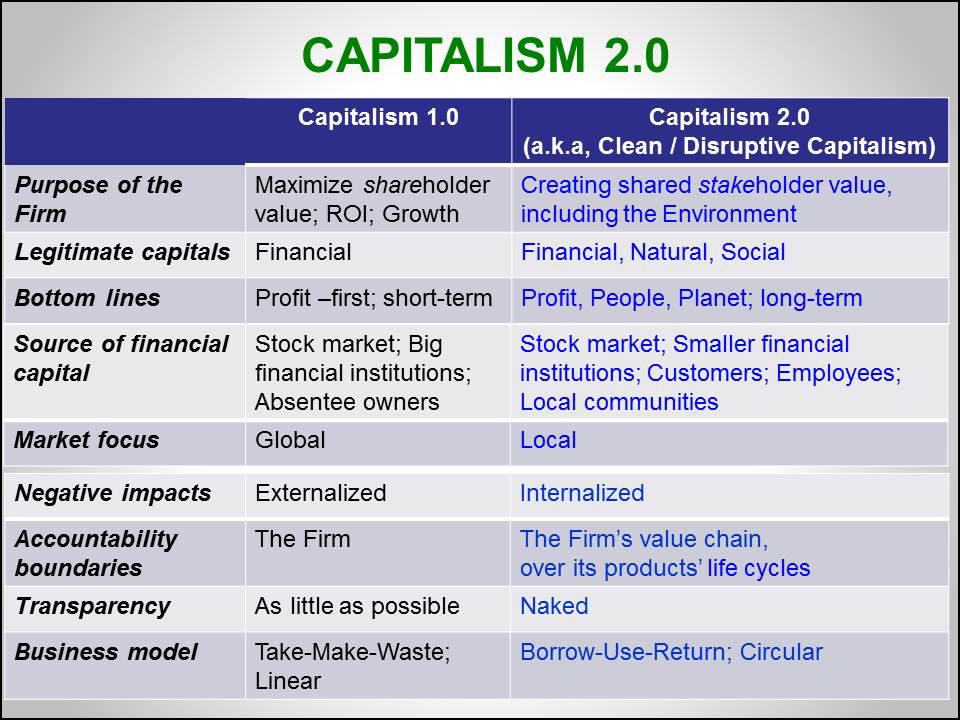Capitalism 2.0
The game of business as we have played it for the last 150 years cannot continue. We are primed for Capitalism 2.0. The current rules of the game reward companies that privatize benefits and gains, socialize harm and losses, and under-price risk.
As Peter Bakker, president of the World Business Council on Sustainable Development, said in a speech at The Prince’s Accounting for Sustainability Forum in December 2012, “Business as usual is not an option for a future-proofed economy in which nine billion people live well within the limits of the planet by mid-century.”
Today’s capitalism has been fun, but it is under siege because it is not sustainable. Today’s business model encourages companies to relentlessly deplete our natural capital. Nature is resilient and self-regenerative, but there is an ecological tipping point beyond which it cannot recover from this abuse. The same is true for society. The widening gap between the have’s and have not’s is unsustainable.
Allen L. White, in his April 19, 2013, article in the Guardian Professional, “Capitalism needs rethinking but what are the options?” observed: “If financial wealth, the paramount metric of contemporary company performance, is built on the unsustainable or unjust extraction of other forms of capital, the long-term prospect for business is grim.”
Nature is too big to fail
We need to remind ourselves about who is in charge. Nature is. The planet can do whatever it wants to. It’s up to us a human species to adjust to the new environment, especially if it is of our own making. We are just another species, and it’s survival of the fittest / most adaptable / most resilient. If other species screw up, their populations collapse. Bad stuff happens. A swarm of locusts consumes itself to death. Some would say that we humans are using them as role models, as we have become the most invasive, over-consumptive species on the planet. We are eating, and fouling, our own nest.
We have no God-given right to stick around, despite the preaching of some religions. If we can’t adapt and figure out how to live, work, and play together on this planet without destroying it, we become extinct and it will be a slow, painful demise. It’s not the banks that are too big to fail: it’s Earth Ltd. We keep forgetting the “limited.”
What should we call it?
When we reinvent capitalism, what should we call it?
There is no lack of labels for a more environmentally and socially sustainable version of capitalism: Volans labels it Breakthrough Capitalism; Corporate Knights calls it Clean Capitalism; John Mackey and Raj Sesoria prefer Conscious Capitalism; Bill Gates used Creative Capitalism as the title of his book; Al Gore and David Blood call it Sustainable Capitalism; and Nicholas Shaxson uses Responsible Capitalism.
Todd Hendersin and Anup Malani call it Capitalism 2.0 in their March 2008 Forbes article with that title. Maybe it’s my data processing background that leans me toward Capitalism 2.0. That’s the label I will use.
Capitalism 1.0 vs. Capitalism 2.0
From the above sources and more, I have gleaned the key characteristics of Capitalism 2.0. The attributes of today’s version of capitalism, Capitalism 1.0, are contrasted with Capitalism 2.0 in this figure.
Capitalism 2.0 acknowledges that genuine wealth is built on more than just financial capital. Allen White in his Guardian Professional article referenced above says: “Capitalism requires a new operating system, and needs to be rebooted so that we expect and manage the return on financial, natural and social capital.” Capitalism 2.0’s value proposition is that stewardship of multiple capitals is the essence of long-term prosperity. In fact, that stewardship becomes a fiduciary duty.
Capitalism 2.0 is the adult version of capitalism
So here’s the deal. We need to grow up, as a species. We’ve been acting like a child living off our parents’ / nature’s limited resources for too long. Our Capitalism 1.0-based economic model assumes the planet’s resources are infinite and that limitless growth is a good thing. We’ve been drawing down our natural capital instead of living off its interest. Any financial planner knows that is unsustainable.
Our collateral damage is coming home to roost. We’ve abused our parent. We need to cultivate respect, humility, fairness, and giving back, to each other and to nature. Or we could adhere to our current “global suicide pact,” as UN Secretary-General Ban Ki-Moon labels our current economic model.
Capitalism 1.0 is not an option. Let’s get on with Capitalism 2.0.
As usual, the above slides are from my Master Slide Set.
Please feel free to add your comments and questions using the Comment link below. For email subscribers, please click here to visit my site and provide feedback.
Bob







Comments are closed.